Menus
- Insane, incredible, breathtaking … There are no qualifiers to describe the sensations felt on the handlebars of the H2-R! But it is the (green) tree that hides the forest since Kawasaki’s real tour de force is to have built a chassis to match the 326 horsepower of its supercharged…
- Presentation
- Compressor
- Motor
- Transmission
- Part-cycle
- Suspensions and tires
- Electronics
- The road H2 or the game of seven errors
- In the saddle
- On track
- The H2 R
- Braking
- Conclusion
- H2R
- H2
Ultimate. Phrase taken from Latin: Highest degree, unsurpassable, which is best…
Insane, incredible, breathtaking … There are no qualifiers to describe the sensations felt on the handlebars of the H2-R! But it is the (green) tree that hides the forest since Kawasaki’s real tour de force is to have built a chassis to match the 326 horsepower of its supercharged mill….
Few of the machines have so inflamed the spirits as the Kawasaki H2-R. So think my good sir, more than 300 horses in something barely heavier than a hypersport has enough to work the imagination. And also make a lot of salivate! Its road version of “only” 200 horses also but in smaller proportions. So yes, there was also a not insignificant amount of cold piss to criticize the two machines: "is useless … too expensive … anvil (probably) uncontrollable … less efficient than a hypersportive (for la H2) ”is just a small anthology of free bird names that have dotted the web of forums during the six months that separated the static presentation at the Intermot Fair from the dynamic presentation in Qatar. The Repaire des Motards having been invited to the party, the moment of the verdict has sounded !
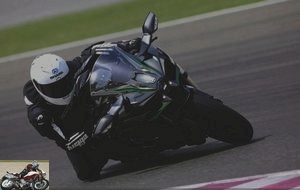
Presentation
Kawasaki has always had a reputation for producing high performance machines. It started in the 1970s with the duo H1 (500 cm3) and H2 (750 cm3), two-stroke three-cylinder engines with a wicked character which quickly gained the nickname of “widowmakers”. A whole program … It is in homage to these breathtaking machines that Kawasaki has taken this name for its duo of new products. Ninja H2 and H2-R. The name Ninja, it makes the link with the long line of sports machines that Akashi’s firm then produced. The first of the name being the GPZ 900 R of 1984. Paradoxically, the choice to affix the Ninja Label on a particular model has long been left to the discretion of the regional branches which has led to some abuses, in particular in the American subsidiary. greens which tended to stick Ninja stickers on everything and anything: GPZ, ER or ZZR … So to guarantee the seriousness and the quality of its two new products, Kawasaki badged them with the River Mark, the logo used in the within the Kawasaki Heavy Industry (KHI) parent company since 1870 and reserved for products with historical significance in the group’s history. Such a logo had disappeared from the group’s motorcycles since the mid-1960s, but since all branches of KHI participated in the development of the H2-R (reserved for the circuit) and its road derivative the H2, they are condensed from the know-how of the Japanese group.
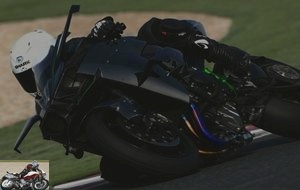
Compressor
Thus, the positive displacement compressor was designed in collaboration with the Motorcycle, Aerospace and Turbine and Machinery departments. This “in-house” development (see interview) made it possible to adapt this element to the very strict specifications defined by Kawasaki. Housed directly behind the cylinder bank, facing the intake, it is of the centrifugal type. The low calorie release compared to a lobe compressor (the most common in cars) eliminates the need for an exchanger, resulting in a saving in weight and bulk. Also to reduce bulk, the compressor is lubricated with engine oil. To make the coffee shop talk about the characteristics of the machine, know that the body of the turbine is carved from a solid aluminum block via a numerically controlled machine, that it has 6 blades at its top and 12 at its base and that its rotation ratio is 9.2 (fixed since it is connected to the crankshaft) and finally that it therefore turns at almost 130,000 rpm when the engine is at full speed (approx. 14,000 rpm / min), moving more than 200 liters / sec. In short, it turns very very quickly. Parenthesis. Some will say to themselves: what if things go wrong? Rest assured, we asked ourselves the same question and one of the Kawasaki staff told us that the housings are oversized to withstand a hypothetical rupture. No need for armored underpants, therefore, end of the parenthesis.

Always at full load, the air pressure is therefore multiplied by 2.4 … Suffice to say that Kawasaki seriously blocked the intake to force-feed its mill with fresh air with two huge Ram Air ducts housed in the head fork and running along the tubular frame. Very straight, so as not to create back pressure, their shape is also the result of a long development in order to accelerate the air flow (Venturi effect) to the compressor. And to avoid deforming under suction, they are made of CFRP (polymer reinforced with carbon fiber). On the other side of the compressor, there is an air box (6 L) made of aluminum, materials offering the double advantage of offering sufficient rigidity to guarantee perfect sealing under 2 bars of pressure and of naturally dispersing heat, cooling thus the air heated by the compressor. Now let’s move on to the next room…
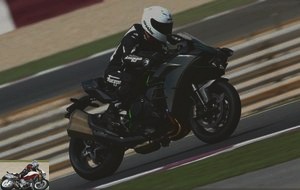
Motor
the four cylinder in line of the H2-R cube 998 cm3 and its super square dimensions (76 x 55) are close to those of its atmospheric counterparts … except for the compression ratio. Supercharging requires, it is much lower than on an atmospheric block with “only” 8.3: 1 against 12.6: 1 on a Ducati Panigale 1299 and even 13: 1 on a Yamaha R1. On the performance side, it’s Palace with 310 horsepower obtained at 14,000 rpm and even 326 horsepower once the boost offered by the Ram Air is taken into account! On the torque side, the H2-R also sets new standards with 165 Nm at 12,500 rpm. By way of comparison, a Ducati Panigale 1299, absolute benchmark for hypersport cars in this area, is announced for 144 Nm.
Unsurprisingly, the intake butterflies are controlled by a Ride by Wire, itself under the orders of an electronic control unit managing all the driving aids in parallel. The design of the combustion chamber and that of the flat-head pistons are inspired by models used in gas turbines produced by the Gas Turbine & Machinery division of Kawasaki. The exhaust valves, subjected to extreme thermal stresses, are bi-composite: the head is made of inconel (an alloy resistant to very high temperatures), the shank is made of steel and the two parts are connected by a friction welding process.
For the low engine, Kawasaki did not skimp on lubrication with an oil capacity of 5 liters (35% more than on a naturally aspirated engine) with pumps feeding the chain of the compressor and its drive mechanism coupled to the crankshaft. , the underside of the cylinders and the gearbox (a first for Kawasaki). For good measure, the engine oil itself is cooled via a water-oil exchanger. For the exhaust, everything becomes simpler. Motorcycle track requires, no need to comply with noise or pollution standards castrating. Result, a 4 in 1 fully titanium ending with a megaphone given for 120 db !

Transmission
Kawasaki has chosen a clutch box as in F1 or MotoGP. Unlike a standard gearbox where the pinions slide on an axis, here they are fixed. As the moving parts are the dogs, which are much lighter, gear changes are both faster and require less effort on the selector..
Part-cycle
Given the available cavalry, the number one priority is to provide impeccable stability at high speed. The simplest solution would have been to lengthen the wheelbase, but Kawasaki considered that this would put too much strain on handling. The engineers therefore preferred to work on the flexibility of the chassis to absorb the torsional stresses between the front axle and the rear. The choice of the greens fell on a tubular trellis in high resistance steel, offering according to them the best stiffness / flexibility ratio and allowing to better dissipate in an optimum way the calories of the engine. Suddenly, the geometry of the H2-R is not very far from that of a Hypersportive with a front axle open to 25.1 ° (24 ° on an R1-M) for a wheelbase of 1450 mm (R1 -M: 1405 mm). The choice of a single-arm, heavier with equivalent rigidity, is justified here by the need to stick the exhaust as close as possible to the center of the machine in order to free the ground clearance on the angle! All the constraints mentioned above have had an influence on the scale, the full weight is officially given for 216 kg.
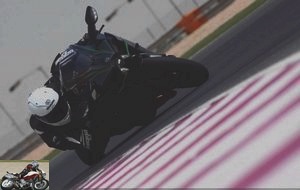
Suspensions and tires
If we find Ohlins, it is only at the level of the electronically controlled steering damper. Kawasaki continues to trust KYB (ex Kayaba) with a rear shock absorber combination adjustable in all directions and a new inverted fork AOS-II 43 mm in diameter at the front. It takes again the technology separating the air and oil cartridges used in motocross with the key to a reduction of internal friction which should – in theory – offer a finer work of the hydraulics. For the tires, Bridgestone is the official supplier with Battlax Racing V01 slicks in 120/600 R17 and 190/650 R17.
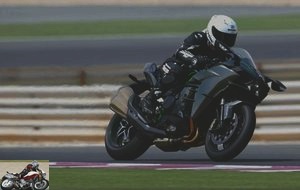
Electronics
If you are a fan of the latest sports tests, you already know the operating principles of all driving aids. The panel is less plethoric here than on the Panigale 1299 and R1-M but the H2-R provides more than the union minimum in this area:
KTRC (anti-slip). If the name is known, the system is brand new with three different levels of settings (1 and 2 for track use, 3 for the road or poor grip conditions), themselves endowed with three “fine” sub-settings. ”, Or 9 possible adjustments.
KLCM (Launch Control). No, it is not a hill start aid. Once engaged, just keep the throttle fully open (the speed is regulated automatically) and let go of the clutch, the electronics taking care of managing the level of rear wheel slip (3 levels of adjustment) for a great start.
KEBC (engine brake control). Once activated, the KEBC reduces the amount of engine brake transmitted to the rear wheel, causing less interference in certain driving phases.
KIBS. The “home” ABS is the same as that used on the ZX-10R, with specific settings tailored to the characteristics and performance of the H2-R. It can be completely or partially disconnected (ABS only at the front).
KQS (quickshifter). First Kawasaki to be equipped with this system, it is only effective when upshifting.
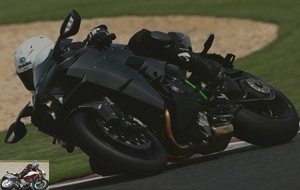
The road H2 or the game of seven errors
The figures displayed by the H2 seem very modest compared to its counterpart dedicated to the track: 200 horsepower at 11,000 rpm (210 with the Ram Air) and 133.5 Nm at 10,500 rpm for 238 kg all full facts. But despite this glaring difference in efficiency, very few parts change from one machine to another. In addition to camshafts with different profiles, the H2 is entitled to a thinner head gasket increasing the compression ratio to 8.5: 1. The engine management unit and the exhaust are specific and the compressor is powered only by a single Ram Air duct. Its clutch has two less discs and the final transmission is shortened (44 teeth on the crown instead of 42). And then to travel on the road, the slicks are replaced by Bridgestone RS10 120 / 70ZR17 at the front and 200 / 55ZR17 at the rear. The four aerodynamic fins disappear, replaced by mirrors.
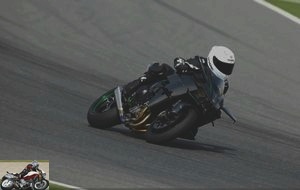
In the saddle
By examining the Kawasaki in detail, it is difficult to find the slightest criticism to make on the finish: screws, cleanliness of the crankcases, quality of the welds, body adjustment … Everything is flawless. And what about the special silver paint except that its photo rendering is very far from transcribing reality. It even becomes disturbing for the retina, each variation of the lighting playing on the different portions of the fairing with the key, the desire to scrutinize it from every angle. Well at least until the mechanics start the engine…
The driving positions of the H2 and H2-R are almost identical. Only the saddle heights differ with 825 and 830 mm respectively. Very narrow at the junction with the tank, the saddle allows a 170 cm pilot wearing track boots to put his 10 toes on the ground but the heels are in the air. The riding position is a bit more relaxed than that of a ZX-10R with higher and wider handlebars. The lateral “hip wedges” adjusted to the most advanced (+ or – 15 mm) touch the rear end in the speed-seeking position and offer excellent support when swaying. The levers, both coupled to radial master cylinders, are adjustable via micrometric screws.
The instrument panel combines digital for the tachometer and digital for information from the on-board computer which permanently displays the speed and the gear engaged. You can also display the total and partial mileage (2 trips), consumption, engine temperature, compressor boost level or even the time. Voluntary gag (?), An Eco indicator is also part of the package. Another joke that turns out to be very practical in use, the tachometer figures light up as the needle climbs, making it possible to instantly visualize the engine speed. And when we approach the red zone, the set of digits will start to flash to signal that it is time to upshift. The driving aids are configured with the left stalk via a very easy-to-use interface. We will leave with everything set to a minimum, the engineers have faith. But it’s time to go. Our handling begins with an H2 fitted for the occasion with the slicks originally fitted to the H2-R.
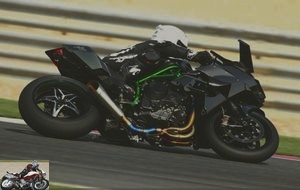
On track
The first turns of the wheel are quite confusing. The 200 horses (210 with the Ram Air) are there but the arrival of the power is unlike anything known in this category with subjectively very deep low revs up to 6,000 rpm before the benefits of the compressor are done feel all of a sudden. The transition is smooth, but the difference in performance gives the Kawa engine two distinct personalities. After that, there is only the sensation of colossal torque which pulls without weakening up to 10,500 rpm of maximum power with the screaming of the compressor escaping from the air box in the background. Beyond that, the thrust is less muscular without the power collapsing, in fact offering 2,500 turns of extension before hitting the breaker. It shows a very full character in the intermediate regimes which contrasts with that of the Hypersportives, more lively to take their turns and more explosive at high revs. The advantage of this overflowing torque is that you can drive a gear above what is recommended without ever running out of power. Only black spots, a clutch with a consistency a little too firm and a somewhat sudden activation of the injection when opening the throttle. This is only noticeable when making the transition between closed accelerator and the first millimeters of butterfly opening. We can bet that this small defect will be corrected during a future update of the ECU. The injection then fulfills its role perfectly with a transparent connection between the right hand grip and the rear wheel, coupled with a dosability of the arrival of power close to the best hypersport cars despite the action of the compressor. The latter is manifested by a characteristic “tchip” of the compressor relief valve at each deceleration. Amusing.
In this track environment, just after testing the Panigale 1299 and R1-M and, the H2 does not disappoint: the compressor torque is worth its weight in peanuts in terms of sensations when you are in its optimal range of use! But we clearly feel that the engine character defined by Kawasaki for this H2 will not give its full extent in the context of road use..
Side chassis, the execution is remarkable but it also typifies “road”. Less incisive than a hypersport and more flexible in suspension, the additional mass is also sensitive in the changes of angles at low speed. At the next session, adopting the hardest settings improves things a bit, but the track is not his area of predilection. Moreover Kawasaki kept telling us throughout the presentation, "the H2 is not a Hypersportive". However, it retains its composition in almost all circumstances. Healthy and even easy once its size is surrounded, the H2 does not require any special skills to drive quickly with a progressive angle, a front axle with very convincing feedback that does not stiffen on the angle under the action of brakes and ground clearance almost impossible to fault. Like a Yamaha, the behavior of an H2 gives its rider confidence. And while the reassuring high-speed stability is there, it’s not to the detriment of handling. Even in the rapid sequences of the Losail track, the H2 does not require that little effort from its driver. The slick-traction control duo (perfect) gives wings when exiting turns and the front wheel regularly wants to take off from the ground on the first three gears without the H2 showing any sign of disapproval. But as soon as it is pushed a little further into its entrenchments, the H2 then reveals its limits. On very (too) late braking, the H2 stiffens and systematically widens its trajectory outside. And in the two large curves which are negotiated in full acceleration, the too flexible rear induces parasitic movements at the front, inducing a slight wavering in the direction. Neither anvil nor scalpel, the H2 just shows the limits of its road definition.
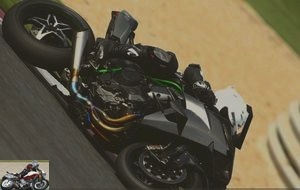
The H2 R
Exhilarated by three morning sessions on the handlebars of the H2, the H2-R offers us its arms after the meal. Here, change of program, I am in my little shoes. The carbon fairing topped with its fins looks menacing and the noise that escapes from the eight H2-R aligned in the boxes gives goosebumps: metallic, shrill, the four-cylinder version "300 horsepower and more" and its Titanium megaphone sounds like an old Formula 1 block (the real ones, not today’s ones). And the mechanics in the process of heating the animals on their crutches did not go beyond mid-speed … Crazy! Attention, I am announcing mandatory earplugs.
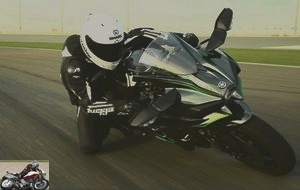
Green flag, start of the pits, I tell myself that we have to go slowly on the first laps but I crack when leaving the last corner before the straight line. Go on! The fork instantly reaches its dead end stop. Argh, quickly pass the 4th so as not to go wheeling … Lost, the thrust is the same as in 3. Fifth? The same ! Where a standard machine sees its thrust water down with speed, it’s almost the opposite happening here. Placed on the ground and freed from the rear tire grip problems inherent at low speeds, the H2-R gives the best of itself after the 100 km / h mark. It calmed down a bit in sixth but we still tumbled at almost 320 km / h (317 according to the on-board computer bug) before having to grab the brakes at the end of the straight line. And unlike the H2, the compressor of this H2-R behaves here like a turbo (without the response time) and from 6000 revolutions, the thrust is only reinforced until the intervention of the breaker. I would love to try to describe the sensations provided by the acceleration of 326 horsepower, but words fail to describe an experience so far removed from all known standards. Ah, yes: a spontaneous reorganization of your anatomy, with the heart which wants to migrate into your underwear and the stomach at the bottom of the socks. And then there is the noise. Well, it’s very, very strong, but hearing pain is still very subjective. For me, for example, if my ears bleed while listening to the New Star, the song that escapes from the titanium megaphone of the H2-R is what comes closest to a mechanical orgasm. We must also talk about the chassis.
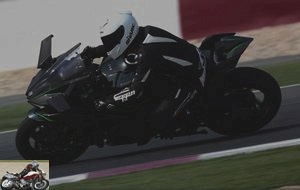
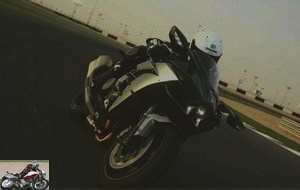
The weight, lowered by almost 20 kilos and a specific hydraulic suspension much firmer transfigure the behavior. Lighter, more lively but also more serene in the phases of acceleration and braking, the H2-R seems to have no other limits than yours (or at least mine). Courageous but not reckless, the go-around on the angle and much more careful than in a straight line but it does not take much to trigger the small light of the anti-skating when you are close to the angle max, whatever the gear engaged. Not so serious since the entry into action of the system and almost imperceptible to driving. In absolute terms, the H2-R chassis still lacks a little something to touch the efficiency of a reference like the Yamaha R1 but the queen of sensations is definitely the Kawasaki..
Braking
To stop its H2-R, Kawasaki has chosen what is currently best on the market, a semi-floating double disc front 330 mm in diameter clamped by radial 4-piston Brembo callipers in forged aluminum. The master cylinder, also radial, also comes from the Italian supplier. The single-sided arm has the right to a single fixed 250 mm disc and a caliper with 2 opposed pistons. The result is, unsurprisingly, flawless: Feedback? Check. Endurance? Check! Power overflowing? Check! Nothing to say about the ABS either, which was triggered only a few times at the rear on the H2, which was softer in suspension. Note that on the H2, the ABS cannot be disconnected. And to get the most out of braking, it is recommended to activate engine brake reduction, which greatly improves stability on very heavy braking..
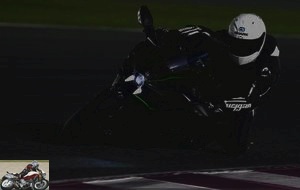
Conclusion
What is the H2-R used for? Nothing and that is probably what makes it so desirable. It is a technical tour de force, a technological showcase, a flagship, the ultimate in excess, a futile object and therefore essential for all those who see motorcycles as a passion or a source of pleasure. With the exception of a dragster, the sensations on its handlebars are incomparable with any known land machine accessible to ordinary people. Afterwards, the selection of the few Happy Fews to be able to benefit from it will be done by the wallet (50,000 €) and the reflexes since only about thirty copies will be available in the French network from the month of May. Hurry, there won’t be something for everyone … Concerning the H2 roadster and its “only” 200 horsepower, it is not a substitute for the R, far from it. But it needs to be tested with us and in its favorite element to judge the real relevance of its concept in the face of more radical Hypersportives but at very similar prices (25,000 €). For this, we will have to wait until January 2016, when France will once again become a free country….
H2R
Strong points
- Insane engine
- The melody of the engine
- Chassis and braking at the height
- Embedded technology
- Out of the ordinary object
Weak points
-
Rare and expensive
- we are still looking ….
H2
Strong points
- Colossal engine torque
- Ease of handling
- Build quality
- Insane braking
Weak points
- With injection shots
- Clutch a little firm
- Weight in use track
Kawasaki H2 / H2R technical sheet
Related articles
-
998 cm3, 210 hp at 13,000 rpm, 11.3 m / kg, 300 km / h, 206 kilos, € 17,799 Breathtaking performance, cutting-edge electronics, pure feel… You may not…
-
4 cylinders in line, compressor, 998 cm3, 210 hp at 11,000 rpm, 137.3 Nm at 9,500 rpm, 260 kilos, € 21,999 Kawasaki reinvents the super-fast and…
-
The grasshopper 10 day trial We have been waiting for several years for a basic to replace the ER-5. In the renewal of its range and in particular…
-
Kawasaki Z H2 Supercharged motorcycle test
200 hp, 14 mkg at 8,500 rpm, 239 kg all full, 17,099 € Put some salt ! Fifteen days of driving with the Kawasaki Z H2? I say it bluntly, it takes less to…
-
Kawasaki ZZR 1400 motorcycle test
The Very High Speed Motorcycle according to Kawasaki We do three kilometers at 200 then at my signal, we open wide. Sitting next to me, assayer Kawa…
-
Kawasaki Z1B Moriwaki motorcycle test
Wild and brilliant roadster 4 cylinders in line, 1,135 cm3, 119 hp, 160 kg It has been exactly 40 years since New Zealander Graeme Crosby entered the GP…
-
Kawasaki VN 1700 Voyager Custom ABS review
Kawa makes the clone …. With her very sleek lowered silhouette and plethora of equipment, this slanted-eyed American is largely inspired by the Harley…
-
Kawasaki Ninja ZX-10R KRT motorcycle test
An integer character 4 cylinders in line, 998 cm3, 203 hp, 114.9 Nm, 206 kg all full facts, 18,099 euros. Nice surprise for me to find the Kawasaki…
-
Tests of the Yamaha YZF R1 and R1M
Magic potion for transgenic hypersports The line of R1 is celebrating its 17th anniversary this year. Unveiled in the aisles of the Milan show, the first…
-
2012 Kawasaki ER-6f motorcycle test
Swiss army knife first price While the ER-6n has been a historic bestseller in the Kawasaki lineup since its debut in 2006, its streamlined “f” version…
"since from 4000 rpm, the torque of the 765 never drops below the maximum reached by the 675 at high speed"
The torque curve of the 675 was already very flat, with an almost constant torque between 4000 and 11000 … which means that the torque does not improve that much despite the 90cc difference.
and again we could have had toad boxes
That’s it, mine has arrived !!!!!!!!!!!!!!!!
Yum yum, strongly on Saturday for our first date.
Very interesting test, but which deserves an update in the conclusion on the Italian price … Too bad also that the Scrambler was not taken on a path, it is supposed to be able to go there at least a little!
I tried the street twin after the Royal enfield interceptor and I preferred the engine of the latter to the Triumph.
It must be said that for the Triumph
It was a clamped version A2…
On the other hand, the driving position on
The Triumph is ideal for those under
1.70m.
Both bikes have rear suspensions
Dry. At the price of the Triumph, this is unacceptable.
900 cm3 and 55 hp ??? even Chinese productions have a better yield.
There is hardly that HD capable of making such poor engines.
Why not 47 hp for the A2 license …
Hello,
at first glance, this displacement / power ratio does indeed seem rather low. However, the torque available, from 2000 revolutions is really important, holding its maximum value (8 da.Nm) up to nearly 6000 revolutions..
The comfort in town, and obviously on the road, is really excellent. The extension is sufficient even if the engine curves fall quickly. A sixth gear would not change much, as the mill is designed to operate at low and mid-speed. The approval is very real. To be tested to be convinced.
Kawasaki France will receive an H2R very soon. No doubt that the comparisons with other machines (cars or motorcycles) should flourish in the press within a few months.
55hp if you have previously had a large displacement, it will necessarily be short. Too bad because this Triumph is a gem. Before talking about engine character any tester should try a Morini. This small brand is dying in general indifference while its scrambler or its 11/2 are mechanical monuments whose engines are assembled by expert female hands (si..si ..) for more patient and attention .
Ok in time for me
But like I said too, thanks for the test
You better stuff yourself, my bitch
Bof, bof … These niche motorcycles, which want to be elitist, lack, precisely, versatility … Everything is designed for aesthetics and the "statutory" position that they want to induce … Nothing is really functional and common sense. Everything is sacrificed for the image…
Result for this Triumph: reduced autonomy, spartan duo, no tachometer, tank cap "walkman" and option, option…
The motorcycle will become either, an accessory for ailments, or, on the other hand, a utility instrument for the broke, with low-end scoots or small displacement…
We could perhaps make pretty, elegant but also functional bikes that don’t quibble about the equipment just because it doesn’t correspond to a certain "look" … It still exists, but I’m afraid it won’t. either more the trend …
12 liters, at 4.5 L / 100 (at "good pace"), that’s 266 km of autonomy
12 liters, at 4.5 L / 100 (at "good pace"), that’s 266 km of autonomy
266 and after you push!
so it takes 220 to break everything before reserve, not terrible
with a 16L you would have your 266 before reserve, and 310 before pushing, which would be correct
when we think of the 22L of the Guzzi V7 …
Most current motorcycles have an average autonomy of 250kms except big trails and roads !!!
except big trails and roads !!!